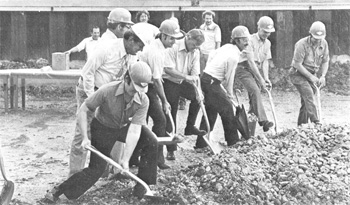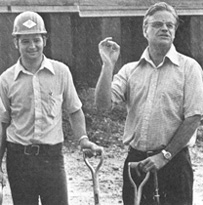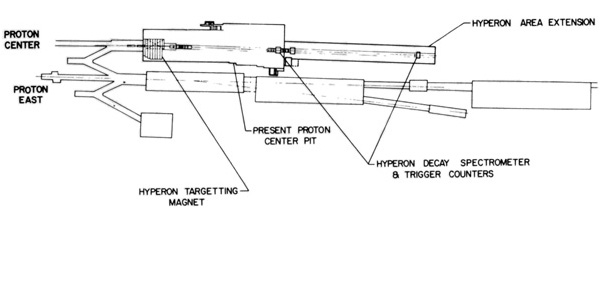Groundbreaking for Hyperon Area
Friday, August 26, was a hot, humid day. Rain clouds had been gathering since early morning. At precisely 3 p.m., Mother Nature emptied the heavens.
The cloudburst is hardly news ... but this one coincided with groundbreaking ceremonies for a charged hyperon beam enclosure in the proton experimental area.
Dampened, but not dismayed, Laboratory Director Robert R. Wilson got the event underway with brief remarks and turned the first shovel of earth. Then shovels were wielded by: Thornton Murphy, head of the Proton Department; Joe Lach, proton department and spokesman for E-497; Dick Majka, Yale University; Dave Eartly, project physicist for Proton Center; Dick Carrigan, Research Division; and Sumner Sollit, president of the construction firm. The participants walked out of ankle-deep mud to light refreshments provided by Yale.
The construction of this new enclosure just downstream of the present proton center enclosure will house a new charged hyperon beam. The first experiment using this beam is E497, a joint Fermilab-Yale University collaboration. Hyperons are baryons like the familiar proton and neutron that make up most of the matter around us, but with one or more of the three normal quarks which make up these particles replaced by strange quarks. The new area is a concrete enclosure 190 feet long by 18 feet wide. It will connect onto the present PC enclosure. The extension is designed to be straddled by the Proton department travel lift which will service it through removable roof hatches. The project is due to be completed in about 90 days. Although the first set of experiments in this area will use charged hyperons, other future experiments will also benefit from having such a long enclosure.
This new enclosure will serve as a staging area for E497; providing a complex spectrometer for identifying hyperons through their decay products that can be built and tested while the present program in Proton-center concludes
Then the large hyperon targeting magnet will be installed. The first experiment, E497, will investigate the strong interaction of hyperons by measuring their elastic scattering properties.
Hyperons are produced by the 400 GeV proton beam striking a target. Because hyperons have very short lifetimes (10-10 - 10-11 seconds) their charge and momentum have to be determined in a very short distance. This will be done by a high field magnet which will also shield the apparatus from the unwanted interactions of the proton beam.
This magnet will be one of the largest at Fermilab, having a field of 35 KG and weighing 350 tons. The hyperon beam coming out of this magnet will be capable of having about 105 Σ¯, 103 Ξ¯ and 10 Ω¯ hyperons emerge per accelerator pulse. These hyperons contain 1, 2, and 3 strange quarks respectively. These intensities are far in excess of existing hyperon beams.
The Ω¯ is the "strangest" of all composed entirely of strange quarks. Since it was discovered in 1964 less than 100 have been observed. By comparison, the famous ψ and ψ' and even the recently discovered upsilon at Fermilab have been observed much more often.
The new hyperon area will provide beams of particles which contain no strange quarks (like pions and protons) to particles which contain three. It will be ideal for studying how the properties of baryons depend on their strangeness content.
There has been much recent excitement with the discovery that elementary particles exist which contain a new "charmed" quark. Much effort is being expended in studying the role of the charmed quark in our zoo of particles. But many theorists, such as Fermilab's Harry Lipkin, point out that we still have a very poor understanding of the role that the strange quark plays in the structure of elementary particles. Hyperons may provide important clues in unraveling these mysteries.





